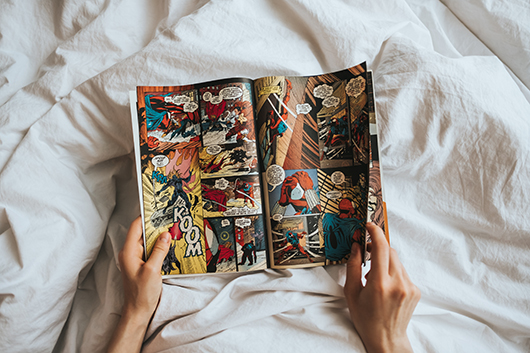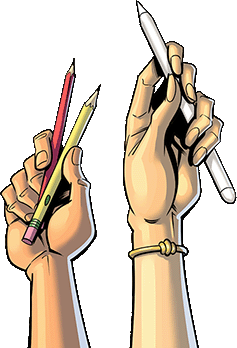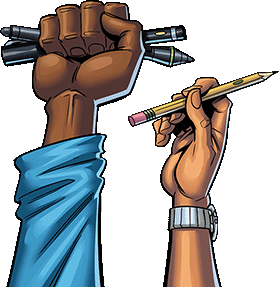What are the Dimensions for Printing Your Own Comic Book?
February 22, 2022
Printing your own comic book is an exciting endeavor that allows you to have complete creative control over your final product. However, knowing the common size dimensions for printing your creative project can be overwhelming if it's your first time.
Learn how many inches wide and long your printed projects should be and the various binding options to consider before you head to the print shop.
What are the Dimensions for Printing Your Own Comic Book?
If you’re considering printing your comic book or graphic novel, there is plenty of specialized knowledge to help a new comic book author make the finished product as professional and polished as possible. One crucial aspect of the printing process is choosing the correct dimensions of your comic.
Bindings, trim, bleeds, paper type, and other decisions determine the quality and price of your book project, and some of these also affect the dimensions of your comic book. Understand these industry-specific terms and how they can work for you.
Printing Terms
To fully understand the ins and outs of the printing process, you need to learn the lingo.
Each moment is encapsulated in a panel on the page, and a row of panels becomes a tier.
The gutter is the area between the panels, both horizontal and vertical. The sheets of pages need to be trimmed to be all the same size. In offset printing, the trim cut is done by a machine in batches. The trim size refers to the size of the pages after the trimming process.
A bleed is the area outside the trim. If you want an image to go all the way to the edges of the paper, you should draw outside the live area, which falls inside the trim cut. This way, when you have an exceptionally stunning piece of art like a splash or a spread, you can make it stand out.
Binding Types
When you are in talks with vendors to get your book ready for printing, they ask you the type of binding you want. Saddle stitched books are popular. Other comic book bindings, in addition to saddle stitched books, depend on the book’s length and how much you’d like to pay for the entire printing process.
Perfect binding
For longer works, like graphic novels, a perfect binding supports the higher page count with a spine. You must have a minimum page count if you want to make a perfect bound book, including the front and rear book cover and pages in between.
Comics that meet the requisite number of pages can opt for the slightly pricier, perfectly bound book. The bindings are easily readable when shelved, and the perfect binding offers a sleek, weighted aesthetic.
Saddle stitched
The majority of comics you come across are saddle stitched, which is when the printer uses offset printing to print out parent pages, which are then folded and trimmed to the page size you've requested.
Once the pages are folded in the right order and facing the right way, the spine is created by stapling the pages together through the middle. Saddle stitched comics are easy to store and transport.
Your binding influences how your book looks and how easy it is to store and transport.
Comic Book Dimensions
There are a few common sizes in the comic book industry, and the most standard size is 6.875” x 10.438” bleed, which is the dimensions before the pages are trimmed down. Usually, this amounts to 6.625” x 10.187” trim. You can use standard book bag sizes to protect your finished product.
You can request custom book page sizes, like 5.5” x 8.5”, but you always want to pick a size that is quickly shelved and reads logically. Individual narratives may benefit from a unique comic book size. However, if it isn’t a necessary design detail, opt for the most used dimensions, which are also the most cost-effective.
Since the paper needs to be trimmed, which is when the edge of the pages are cut down, you should make sure that all the lettering and artwork falls in the live area, which is the leftover area at the edge of the pages.
The 6.875” x 10.438” wasn’t always the standard size for comics; dimensions have changed as comic books evolve. Depending on the price of paper, the standard dimensions of a comic grew and shrunk, and the number of pages also changed.
Number of Pages
The Golden Age of comics was usually 64 pages, which accounted for 4 or 5 adventures between the covers. As the paper price went up, the page count shrunk to 48 and then to 32.
If you want your book saddle stitched, you must submit a manuscript with a page count divisible by 4. The number of pages in your book will be twice the number of sheets of paper. Since the book is stapled in the middle, two pages are printed on one sheet of paper.
Types of Paper
For comic book printing, another vital style decision is what type of paper you want the interior pages to be and if they differ from the cover. Most comics use uncoated paper for the inside and glossy, heavier paper for the front and back covers. The glossiness works well with cover artwork, which is usually a showstopper.
Along with comic sizes and bindings, you have to decide between black-and-white or color printing. Like noir detective thrillers, the pages look great when printed in black-and-white because the strong contrasts mesh with the comic book’s themes.
Color printing makes the most use of the gorgeous artwork inside your comic book. If you want your creative output to really shine, opt for color printing, at least for the cover.

Start Your Printing Journey
There are many creative aspects to making a comic book or graphic novel. You also have to consider technical factors to make a polished, finished work.
Comix Well Spring can help you get from a great idea to a finished comic book in no time. With our expertise, you can make the right choices in dimensions, trim size, and binding type for your comic.


